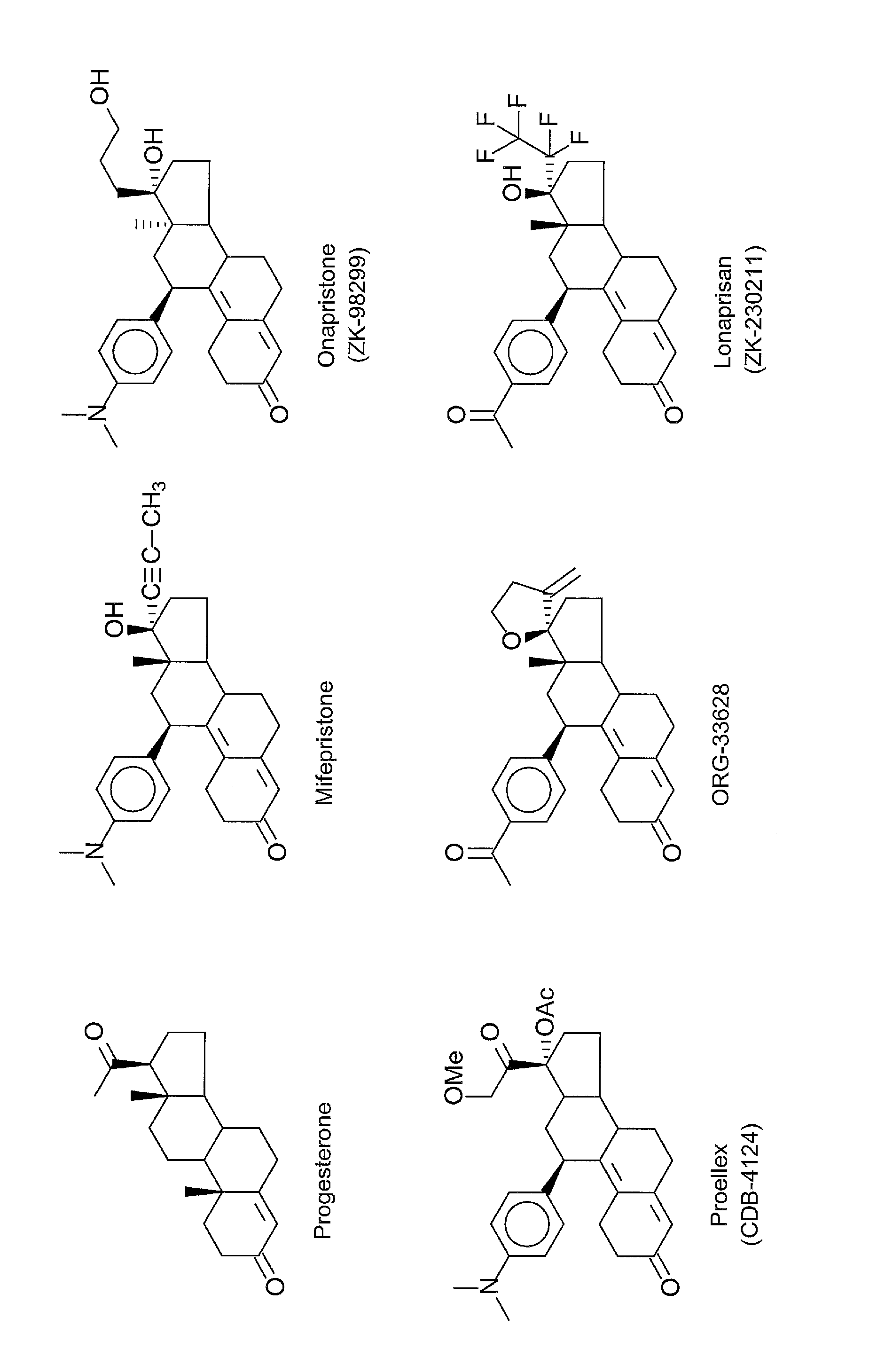Progesterone antagonists
a technology of progesterone and antagonists, applied in the field of suppressing the growth of cancer, can solve the problems of limited long-term clinical use, significant biochemical changes, and slight change in shap
- Summary
- Abstract
- Description
- Claims
- Application Information
AI Technical Summary
Benefits of technology
Problems solved by technology
Method used
Image
Examples
example 1
3,3-Ethylenedioxy-21,21-difluoro-17,23-epoxy-19,24-dinor-17α-chola-5(10),9(11),20-triene (3)
[0087]To a solution of diisopropylamine (0.95 mL, 6.8 mmol) in THF (10 mL) at −78° C., n-BuLi (2.7 mL, 2.5 M, 6.8 mmol) was introduced and stirred for 30 minutes. A solution of diethyl difluoromethylphosphonate (1.1 mL, 6.8 mmol) in THF (10 mL) was added and stirred for 1 hr at −78° C. Finally, a solution of 3,3-Ethylenedioxy-4′,5′-dihydrospiro[cstra-5(10),9(11)-diene-17β,2′(3′H)-furan]-3′-one (2) (Jiang et al., Bioorganic and Medicinal Chemistry, 2006, 14, 6726) (1.0 g, 2.7 mmol) in THF (10 mL) was added dropwise, stirred for 30 minutes at −78° C., slowly warmed to room temperature during 1 hr and heated to reflux for 15 hrs. The reaction mixture was quenched with water (30 mL) and extracted with ethyl acetate (3×25 mL). The combined organic layer was washed once with brine, dried over sodium sulfate and evaporated in vacuo to afford crude product. Purification was carried out on silica gel ...
example 2
3,3-Ethylenedioxy-21,21-difluoro-5α,10α;17,23-bisepoxy-19,24-dinor-17α-chola-9(11),20-diene (4)
[0089]Hydrogen peroxide (0.18 mL, 30%, 1.6 mmol) was added to an ice-cold solution of hexafluoroacetone trihydrate (350 mg, 1.6 mmol) in dichloromethane (3 mL). Solid Na2HPO4 (180 mg, 1.3 mmol) was introduced, and the reaction mixture was stirred for 1 hr at 0° C. An ice-cold solution of (3) (400 mg, 1 mmol) in dichloromethane (3 mL) was added and the mixture was stirred at 0 C for 3 hrs then at 5 C for 15 hrs. The reaction mixture was diluted with dichloromethane (15 mL) and washed with 10% sodium sulfite solution (15 mL), water, dried over sodium sulfate and concentrated under vacuum to obtain a mixture of crude epoxides. Separation of isomeric epoxides was carried out on a silica gel column using 10% ethyl acetate in hexane to afford 230 mg (55%) of pure α-isomer (44).
[0090]1H NMR (δ, 300 MHz) 0.85 (s, 3H), 1.1-2.9 (m, 20H), 3.6-4.0 (m, 6H), 5.8-6.0 (m, 1H).
example 3
3,3-Ethylenedioxy-21,21-difluoro-5α-hydroxy-11β-{4′-[1′,1′-(ethylenedioxy)-ethyl]phenyl}17,23-epoxy-19,24-dinor-17α-chola-9(10),20-diene (5a)
[0091]A slurry of magnesium (85 mg, 3.5 mmol) in THF (5 mL) containing a crystal of iodine was taken and heated to reflux for 10 minutes to become colorless. A solution of 2-(4-bromophenyl)-2-methyl-1,3-dioxolane (835 mg, 3.5 mmol) in THF (5 mL) was introduced during 5 minutes and allowed to reflux for 1 hr. The reaction mixture was cooled under ice and solid CuCl (100 mg, 1.0 mmol) was added to the mixture. The mixture was stirred at 0 C for 30 minutes. Finally a solution of (4) (480 mg, 1.15 mmol) in THF (5 mL) was added into the cuprate solution and allowed to stir for 2 hrs at 0 C. After this time the reaction mixture was quenched with aqueous ammonium chloride solution (30 mL) and extracted with ethyl acetate (3×25 mL). The combined organic layer was washed further with water and brine, dried over sodium sulfate and evaporated in vacuo to ...
PUM
| Property | Measurement | Unit |
|---|---|---|
| pH | aaaaa | aaaaa |
| temperature | aaaaa | aaaaa |
| volume | aaaaa | aaaaa |
Abstract
Description
Claims
Application Information
 Login to View More
Login to View More - R&D
- Intellectual Property
- Life Sciences
- Materials
- Tech Scout
- Unparalleled Data Quality
- Higher Quality Content
- 60% Fewer Hallucinations
Browse by: Latest US Patents, China's latest patents, Technical Efficacy Thesaurus, Application Domain, Technology Topic, Popular Technical Reports.
© 2025 PatSnap. All rights reserved.Legal|Privacy policy|Modern Slavery Act Transparency Statement|Sitemap|About US| Contact US: help@patsnap.com



